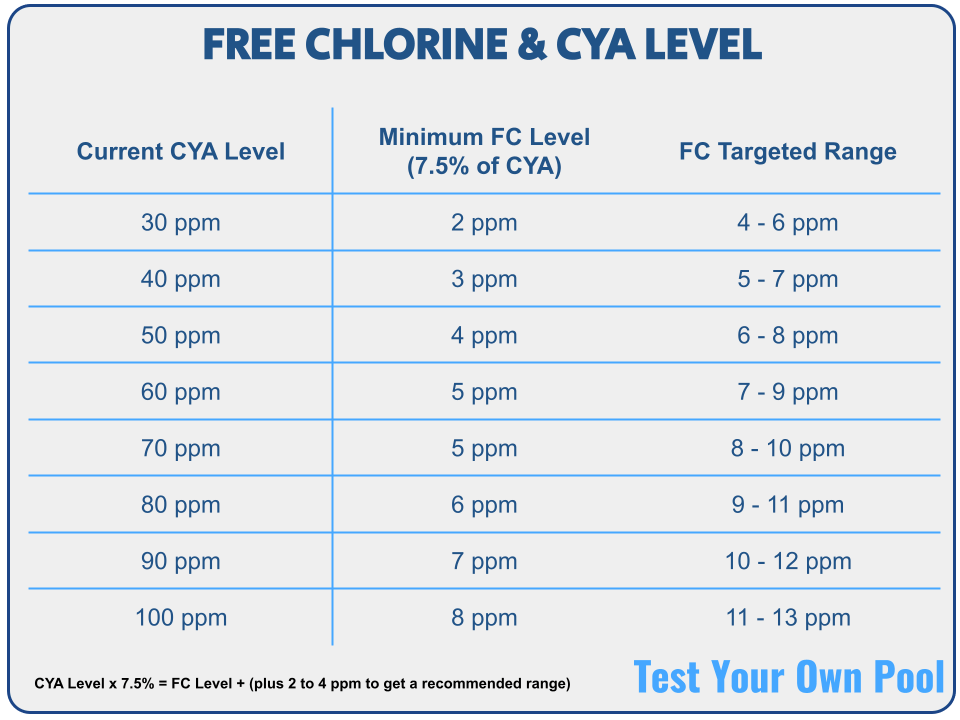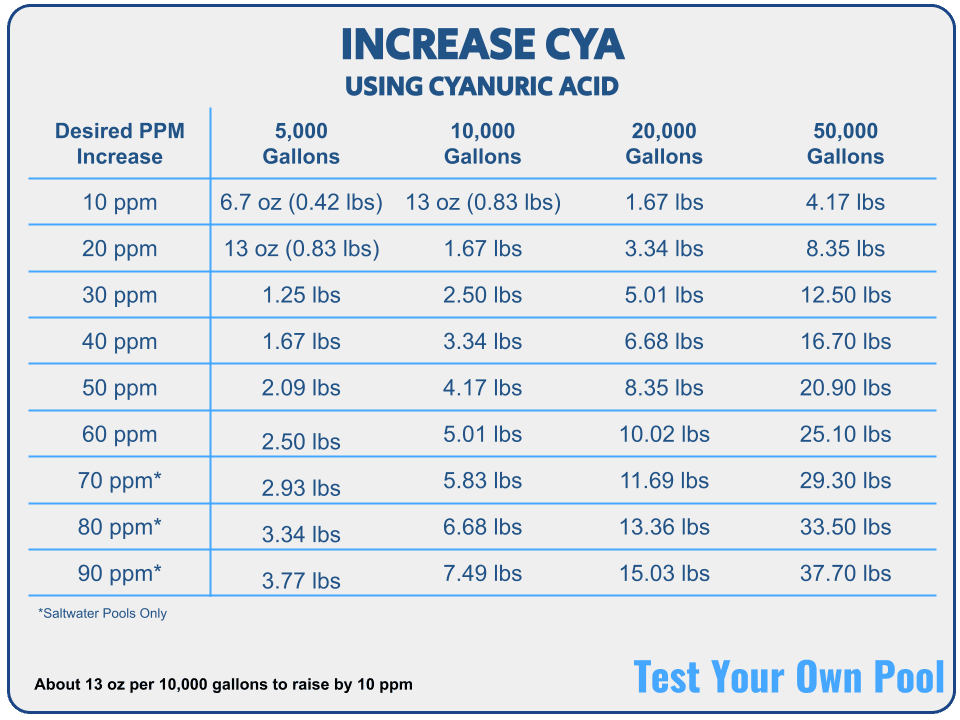Cyanuric acid (CYA) is a stabilizer that acts as a “protector” of chlorine. It shields chlorine from UV light degradation and blocks its harshness in the water.
This protection will help chlorine last longer in the pool which helps chlorine sanitize the pool for longer periods. Let’s dive into the basics of cyanuric acid, how to test CYA, and how it works in overall pool chemistry.
How Cyanuric Acid Impacts Pool Water
CYA is a buffer for chlorine in the water. When chlorine “contacts” CYA, it is put on standby until needed to attack bad organisms or contaminants in the water.
It determines the amount of free chlorine that is active and available to use.
It is usually only needed for outdoor pools where UV rays severely degrade the effectiveness of chlorine. Pools indoors typically do not have this issue.
Helps reduce chlorine loss due to sunlight and organics. 7-pound bag.
What Happens When CYA Is Not Balanced?
There is only one negative effect of having CYA too far out of the recommended levels, but it is still a big deal.
CYA levels that are too low will cause chlorine to be less effective, forcing you to use more chlorine daily to keep it around 1-3 ppm, which is the minimum FC should be. This game of cat and mouse can be very annoying and expensive to maintain.
Similarly, higher-than-normal CYA levels will also cause chlorine to be less effective, weakening its efforts and forcing you to use more to keep it at the recommended levels.
One of the most common causes of high CYA is using stabilized chlorine, such as trichlor (tablets) or dichlor, as your everyday chlorine source. These have cyanuric acid in their makeup, so every time a trichlor puck is added to the water, CYA will increase.
If you are solely using tabs in a floater for your chlorine source, please check your CYA and act accordingly if it is too high.
How to Test Cyanuric Acid in a Pool
Every testing kit and test strip will consider CYA in their testing results. Remember that CYA can only be removed from water by draining and refilling, so accuracy is key.
Using a testing kit will provide overall accuracy and comfort, knowing more exact results.
The most accurate and reliable pool testing kit.
Type of Chlorine Test: FAS-DPD
Read our full Taylor K-2006 Review.
CYA should always remain between 30 to 60 ppm. Owners with a saltwater pool can afford to keep CYA on a higher level, about 60 to 90 ppm.
CYA doesn’t change levels too much unless there is a big exchange of water from a storm or a drain and refill. So, testing for CYA can be done less frequently than other methods, on a weekly or even monthly basis.
Further Understanding The Relationship Between CYA and Free Chlorine (FC)
Because CYA is a buffer to FC, CYA should always determine how much FC is in the pool.
This has been a highly debated subject for years. However, it’s been pretty well established by brilliant people like Richard Falk that pools need at least 7.5% of the CYA level to be FC in order to fight algae growth. So, with that in mind, the following FC levels should be recommended based on CYA using the following math equation:
CYA Level x 7.5% = FC Level + (plus 2 to 4 ppm to stay a little above)
Ideally, you should be in the higher range of these estimates but never fall below the minimum (nearest whole number).
To check what FC range you should be in, plug in the current CYA of your pool:
Free Chlorine & CYA Levels
You can also refer to this chart for a full overview of the FC and CYA relationship:

Notice how much chlorine is needed to be effective when CYA starts to climb up. This is why testing CYA is crucial to ensure it’s always at a balanced level.
You can certainly swim in a pool with either a lower or higher CYA level as long as free chlorine (FC) levels are within the minimum requirements. Many public pools run perfectly fine with 0 CYA.
Lower CYA levels will lessen chlorine’s longevity, so it will have to be added more frequently.
Testing CYA in a Pool
This testing procedure will follow Taylor’s turbidity testing method, though most other methods follow the same general guidelines.
One item to remember is that the water temperature affects the CYA test. Make sure the water sample is warmer than 70 degrees.
If you are testing pool water below 70, take it inside to warm up or run hot tap water to the water sample until it gets warmer.
Gather a Good Water Sample
Use the CYA bottle the testing kit provides or a clean cup and go to an area in the pool’s deep end that is away from skimmers or return jets. Then, insert the cup straight into the water about elbow deep, creating an air gap. Lastly, turn the cup over until it fills.
Fill the CYA bottle With Water Sample to First Designated Line
The CYA bottle should have two lines. The first line can be labeled as 7 mL or 14 mL, depending on the test. Fill the sample to the first (lower) line.
Add R-0013 Reagent to Second Fill Line
R-0013 is the cyanuric acid reagent. It contains melamine which binds to the cyanuric acid causing the sample to turn a bit cloudy (which is completely normal and what should happen when CYA is present).
Cap and Mix for 30 to 60 Seconds
Cap and close the mixing bottle and shake for up to a minute. You want to ensure the sample and reagent are completely mixed together, so shake vigorously if necessary!
Slowly Pour the Sample into Comparator Tube until Black Dot Disappears
Most Taylor tests, like the K-2006, will have their CYA and pH comparator tubes as one block. You’ll notice the CYA tube will have numbers on the side.
To accurately perform the test, stand outdoors with your back facing the sun. Hold the tube at waist level and pour the sample into the tube slowly. An easy way to test is to fill the tube up to each number and view it into the tube. If the black dot is still visible, pour to the next number. Continue until the black dot is no longer visible.
Taylor has a visual that shows what each step of the test should look like :

Read the Comparator Tube Number and Record as Parts Per Million (ppm)
There are a couple of options that can occur depending on how much CYA is actually in the water:
- If the tube is not completely full, look at the side of the tube and record the number as ppm. If it is between two numbers, round up to the higher one. For example, if the sample is between 40 and 50, record it as 50 ppm.
- If the tube is completely full and the dot is still plainly visible, then CYA is 0.
- If the tube is completely full and the dot is only partially visible, then CYA is above 0 but below the lowest measurement, the test allows, usually 30 ppm.
If High CYA is Expected, Try An Alternative Testing Method
If you already know the CYA test will result in higher than 90 ppm or the test shows the dot missing before the first recorded number, repeat the test with a few adjustments:
- Fill the CYA mixing bottle to the lower line with the water sample.
- Fill the bottle to the upper line with tap water.
- Shake the bottle to mix the tap water and sample water.
- Pour half of the water out until you return to the lower line.
- Continue normally and add R-0013 reagent.
- Multiply the final result by 2
How to Lower CYA in the Pool
Draining and refilling with fresh water is the only method proven effective in lowering CYA in a pool. You might see some chemicals at a pool store that will claim to lower the levels, but by and large, they are ineffective.
How to Raise CYA in the Pool
CYA is raised by adding cyanuric acid. It is primarily found in granular form, which is the most inexpensive type. Liquid CYA is easier to use and handle, but it is more expensive.
Here is a handy CYA calculator that details how much you need to add based on the desired increase in ppm. You will also need to know your pool volume.
How Much CYA to Add
Refer to this chart for a quick overview. Remember that these are all estimations, so if a large addition is necessary, add small doses and test in between.

Keep it All Balanced
You don’t have to understand the intricacies of cyanuric acid, just how it affects the overall water chemistry. We want chlorine to be as effective as possible when it is in the water.
Its job is to kill contaminants and make the pool as clean as possible. We must ensure it is in the perfect environment.


